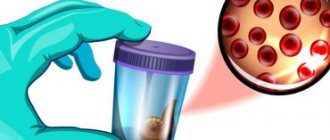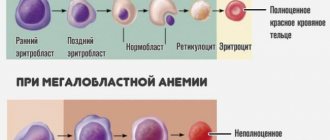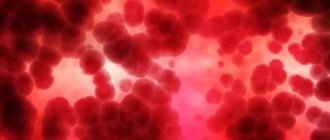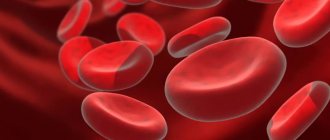Why is human blood red?
Science knows that different living organisms on the planet have different blood colors.
However, in humans it is red. Why is blood red? This question is asked by both children and adults.
The answer is quite simple: the red color is due to hemoglobin, which contains iron atoms in its structure.
What makes blood red is hemoglobin, which consists of:
- From a protein called globin,
- The non-protein element heme, which contains the ferrous ion.
There are four hemes in hemoglobin molecules.
Their number is 4 percent of the total mass of the molecule, and globin accounts for 96 percent. The main effect in the activity of hemoglobin belongs to the iron ion.
Ferrous oxide makes blood red.
The metal that promotes the reproduction of red blood cells is continuously produced by the human body.
Nitric oxide, in turn, plays an important role in regulating blood pressure.
Types of blood
| Arterial | Venous |
| Rich in oxygen, comes from the heart. A bright scarlet hue distinguishes arterial blood from venous blood. | Gives oxygen to organs and returns to the heart. The dark red tint is a distinctive feature. What makes this blood dark is the carbon dioxide that fills it. |
Hemoglobin
This is a complex protein that includes a pigment group. One third of the red blood cell consists of hemoglobin, which makes the cell red.
Hemoglobin consists of a protein - globin, and a non-protein pigment - heme, containing ferrous ion. Each hemoglobin molecule includes four hemes, which account for 4% of the total mass of the molecule, while globin accounts for 96% of the mass. The main role in the activity of hemoglobin belongs to the iron ion. To transport oxygen, heme reversibly binds to the O₂ molecule. Ferrous oxide is what gives blood its red color.
Compound
Blood is a rapidly renewing connective tissue that continuously circulates throughout the human body.
It was possible to find out what gives the red color, but its elements turn out to be no less interesting. What elements give it this color is an equally interesting aspect.
Blood contains:
- Plasma. The liquid is light yellow in color, with its help the cells in its composition can move. It is composed of 90 percent water, with the remaining 10 percent made up of organic and inorganic components. Plasma also contains vitamins and microelements. The light yellow liquid contains many beneficial substances.
- Formed elements of blood cells. There are three types of cells: white blood cells, platelets and red blood cells. Each type of cell has certain functions and characteristics.
Leukocytes
These are white cells that protect the human body. They protect it from internal diseases and foreign microorganisms penetrating from the outside.
Leukocytes
This is a white element in color. Its white tint cannot be ignored during laboratory tests, so such cells are identified quite simply.
White blood cells recognize foreign cells that can cause harm and destroy them.
Platelets
These are very small colored plates whose main function is coagulation.
Platelets
These cells are responsible for ensuring that the blood:
- It coagulated and did not flow out of the body,
- Coagulates quite quickly on the surface of the wound.
Red blood cells
More than 90 percent of these cells are in the blood. It is also red because red blood cells have this hue.
Red blood cells
They carry oxygen from the lungs to peripheral tissues and are continuously produced in the bone marrow. They live for about four months, then are destroyed in the liver and spleen.
It is very important for red blood cells to carry oxygen to various tissues of the human body.
Few people know that immature red blood cells are blue, then acquire a gray tint and only then turn red.
There are quite a lot of human red blood cells, which is why oxygen reaches peripheral tissues so quickly.
It is difficult to say which element is more significant. Each of them has an important function that affects human health.
Red in painting: from sexuality to power
In secular images, the color red is no less important than in icons. Often, an artist uses red to make a dramatic accent, to draw the viewer's attention to a certain detail in the landscape or a character's clothing.
15th century: new possibilities of red
During the Renaissance, religious images gradually gave way to secular ones, and the place of pious Madonnas was taken by naked Venuses.
Painting techniques are also evolving: artists are moving from tempera to oil paints. The fact is that tempera was made from a mixture of powder pigments and egg yolk, so the paint dried instantly. The artist had to apply color very quickly and could not allow errors in the drawing: it was almost impossible to correct anything later.
Another thing is oil paints: they can be applied in a thin layer, layering one color on top of another and thus achieving an unprecedented depth of color. An oil painting can be easily corrected, wiped off with a solvent, or completely scraped off the surface.
It is believed that oil painting became widespread in Europe thanks to the Fleming Jan Van Eyck, who was tired of working according to the old method.
Oil not only helped him expand his palette, but also allowed him to introduce numerous details into his paintings. The main color of his works, be it the Ghent Altarpiece or the Arnolfini Portrait, was red.
Jan Van Eyck "Portrait of the Arnolfini couple" (1434).
Red remained a very expensive dye, and only wealthy people could afford scarlet fabrics. The fact that almost all the furniture in the couple’s bedroom is upholstered in red fabric speaks of their wealth.
Jan Van Eyck "Portrait of a Man in a Red Turban" (1433).
Researchers believe that this is a self-portrait of Van Eyck. The red turban was excellent advertising for him - proof of success and access to the most coveted dyes of his time.
16th century: red - Titian's brand
The main masters of the early 16th century - Michelangelo, Raphael and Leonardo da Vinci - did not pay much attention to red. But Titian, who replaced them, made a name for this color, and in the literal sense.
In his “Venus of Urbino” or “Woman with a Mirror” there is a shade completely different from the red that was found among his contemporaries. As a result, they began to call him by the name of the one who glorified him - “red Titian.”
Titian "Venus before a Mirror" (1555).
This special color of a warm, reddish-brownish-orange hue gives his paintings a sensual feel and Titian's were so popular that they even influenced ladies' fashion of the time. The artist's contemporaries bleached their hair and then dyed it with turmeric and saffron.
17th century: red is the color of pleasure
The 17th century is the triumph of the Baroque style, focused on wealth and excess. Architects create incredibly complex forms, and artists depict magnificent celebrations.
The paintings of the Flemish artist Paul Rubens became a real celebration of color in painting. His palette is always built on complex, almost dramatic color contrasts, where red symbolizes great passions and intense emotions.
Rubens "Tarquin and Lucretia" (1609–1611). Source
Rubens "Susanna and the Elders" (1607).
Rubens "The Rape of the Daughters of Leucippus" (1618). Source
In the paintings “Tarquin and Lucretia”, “Susanna and the Elders”, “The Abduction of the Daughters of Leucippus”, the red color appears very pointwise, only on the fabric that hides the private parts. This is very symbolic, because in all these stories we are talking about the dishonor of girls.
And in “The Fatherly Love of a Roman Woman,” where Rubens interprets the ancient story of the old man Cimon and his daughter Pero within the framework of the Christian concept of mercy, red emphasizes the young and healthy female body.
Rubens “The Fatherly Love of a Roman Woman” (1612).
But for the Baroque it was important not so much to talk about the girl’s nobility as to emphasize her sexuality.
18th century: red - a secular compliment
After the stormy baroque passions, the artists wanted peace and harmony. Scenes of large celebrations gave way to intimate settings, and at this time the portrait genre was gaining popularity. Wide windows and large doors appear on the canvases, which means it becomes much easier to see the color. Light shades and delicate pastel colors are now in fashion. But in England and Russia, red remains popular with the most advanced artists.
Joshua Reynolds, the first president of the Royal Academy of Arts in London, was an incredibly sought-after portrait painter. He could accurately convey the main features of his models and at the same time carefully flatter them. It is not surprising that among his customers were the most prominent people of their time: members of the royal family, society ladies, politicians, artists and writers. Almost every portrait necessarily has an expressive spot of red.
Joshua Reynolds "Self-Portrait" (1749).
But today many of his paintings seem dark and faded - were all his famous clients lining up for them?
Reynolds became a victim of his own experiments with paint. To achieve a deep shade of red, he added raspberry carmine on top of the cinnabar, which faded over time. Therefore, the heroes of his portraits today look painfully pale, looking more like marble sculptures than living beings.
Joshua Reynolds "Portrait of Jane Fleming, Countess of Harrington" (1779). Source
It is impossible not to mention Karl Bryullov, whose fame spread far beyond the borders of Russia. And although he already lived in the 19th century, his work reflected the trends of the previous century.
Like Reynolds, he balanced between strict academicism and sensual romanticism, exalting his models and emphasizing their delicate beauty. If he wanted to compliment someone, he would definitely use his favorite red. In all the portraits, his muse, Princess Yulia Samoilova, is depicted against the backdrop of a scarlet theater curtain: this rich society lady delighted the painter with her independent behavior and extraordinary actions.
Karl Bryullov “Portrait of Countess Yu. P. Samoilova leaving the ball with her adopted daughter Amazilia Pacini” (no later than 1842).
Here Bryullov separated the Countess from the rest of the crowd with red flowing velvet, as if emphasizing the special position that this woman occupied not only in society, but also in the life of the artist.
19th century: red is the color of the people
In the 19th century, red finally lost its connection with the aristocratic past and became the color of the people. Having first appeared on the caps of French rebels, it soon acquired ideological significance - revolutionary, extremist. The revolution will end, but the political meaning of the color red will remain throughout the century.
Red is not only a revolution, but also attention to the common people. At the end of the 19th century, post-impressionist Vincent Van Gogh moved from Paris to Arles to open an art commune with his idol Paul Gauguin. For Van Gogh it was a period of great hope and grandiose works. He carefully studied the life of peasants and reflected on the power of nature.
In the painting “Red Vineyards in Arles,” the setting sun heats up the earth so much that it becomes crimson-red, reminiscent of flashes of flame. Daylight is drawing to a close, but the grape pickers have not yet finished their hard work. To convey the disturbing and dark nature of this motif, Van Gogh covers almost the entire canvas in red.
Vincent Van Gogh "Red Vineyards at Arles" (1888). Source
In the painting “Night Café on Place Lamartine in Arles,” Van Gogh shows the modest setting of a drinking establishment for the working class. Vagrants can even go there to take a nap for an hour or two - we see them on the right side of the picture. Compositionally, the plot is built on the contrast of red and green: “In this picture I tried to express frantic human passions in red and green,” the artist wrote to his brother.
Vincent Van Gogh "Night Café on Place Lamartine in Arles" (1888). Source
In the life of the artist, the color red also became a symbol of great passions. Van Gogh used red paint with a high lead content. He had a habit of wetting his brushes in his mouth - it turns out that he was constantly poisoning himself with heavy metal. There is a hypothesis that the real reason for his aggression and constant insomnia was not his explosive nature, but the toxin in the red paint, which aggravated the artist’s condition.
But it wasn’t just the red that Van Gogh used that was poisonous. Many shades of color were toxic until the advent of factory-made analogues. For example, cinnabar was made by heating sulfur and mercury (this shade can be seen in the frescoes of Pompeii). Both realgar, made from arsenic sulphide, and red lead, which were used by artists of the Renaissance and Modern times, were both harmful.
First half of the 20th century: the color of French savages
The beginning of the 20th century was a time of great discoveries. Artists suddenly pay attention to colonial art, rethink children's drawings and actively experiment with color and form.
The Impressionists talked about separate strokes and painting with pure color. Now the artists of the next generation are taking these same attitudes to the limit. The master conveys a shadow with a blue tint as pure turquoise, and the light blush on the girl’s cheeks as a crimson spot.
A whole movement of painters appears who are only interested in coloristic tasks. For their love of bright colors they were nicknamed Fauves (from the French fauves - “savages”).
Henri Matisse, the main ideologist of Fauvism, believed that the main thing in a painting is the harmony of color. He built all his compositions on the relationship of contrasting colors, which gave a major tone to his static subjects.
He initially painted the canvas “Red Room” in blue, but decided to redo it almost entirely, considering that the work did not look decorative enough (in other words, there was no feeling that it was a tapestry or carpet). But Matisse considered the “red” version much more beautiful.
Henri Matisse "The Red Room" (1908). Source
Explanation for the child
Children often ask questions regarding the components of the human body. Blood is one of the most popular topics of discussion.
Explanations for children should be extremely simple, but at the same time informative. Blood contains many substances that differ in function.
Consists of plasma and special cells:
- Plasma is a liquid that contains useful substances. It has a light yellow tint.
- The formed elements are erythrocytes, leukocytes and platelets.
The presence of red erythrocyte cells explains its color. Red blood cells are red by nature, and their accumulation leads to the fact that a person’s blood is exactly this color.
There are about thirty-five billion red cells that move throughout the human body in the blood vessels.
What is blood really?
Human blood is not just a liquid. It contains a lot of different elements that distribute nutrients throughout the body and fill our tissues with oxygen. Most of our blood consists of plasma, in which blood cells (formed elements) are suspended, and any substances that are carried (besides oxygen) dissolve here. Plasma is the most important component of this important liquid and is very pale in color with a yellow tint. But as soon as the formed elements dissolve in it, it sharply changes its color and becomes slightly cloudy. The most common type of blood cell found in plasma is red blood cells, which contain a protein called hemoglobin.
Why are veins blue
The veins carry burgundy blood. They are red, like the color of the blood that flows through them, but not blue. The veins only appear blue.
This can be explained by the law of physics about the reflection of light and perception:
When a ray of light hits the body, the skin reflects some of the waves and looks light. However, it transmits the blue spectrum much worse.
The blood itself absorbs light of all wavelengths. The skin gives a blue color for visibility, and the vein is red.
The human brain compares the color of the blood vessel against the warm tone of the skin, resulting in blue.
Blood of a different color in various living creatures
Not all living organisms have red blood.
The protein that gives this color in humans is hemoglobin, contained in hemoglobin. Other living beings have other fat-containing proteins instead of hemoglobin.
The most common shades besides red are:
- Blue. Crustaceans, spiders, mollusks, octopuses and squids boast this color. And blue blood is of great importance for these creatures, as it is filled with important elements. Instead of hemoglobin, it contains hemocyanin, which contains copper.
- Violet. This color is found in marine invertebrates and some mollusks. Typically, such blood is not only purple, but also slightly pink. The blood of young invertebrate organisms is pink. In this case, the protein is hemerythrin.
- Green. Found in annelids and leeches. The protein chlorocruorin is close to hemoglobin. However, iron in this case is not oxide, but ferrous.
The color of blood varies depending on the protein it contains. Whatever the color of blood, it contains a huge amount of useful substances necessary for a living organism. Pigment is important for every organism, despite its diversity.








